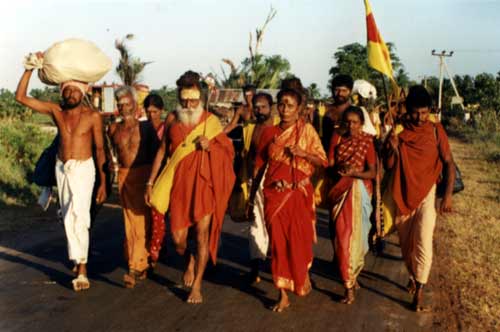
|
|||||||||||
|
| |||||||||||
 Kataragama Pada Yatra pilgrims reach TrincomaleeFirst pada yatra since 1983 from Mullaitivu, Jaffna districtsColombo: Ceylon Daily News article of June 10, 2002
|
 |
|
Kataragama Pada Yatra pilgrims on the move. |
 |
|
Kataragama Pada Yatra pilgrims crossing Sambaltivu Lagoon on 5 June 2002. |
(Trincomalee, June 6) Sinhalese and foreign devotees joined ardent Tamil devotees from Jaffna, Mannar, Vavuniya and Trincomalee who assembled in Mullaitivu District at Vattappalai Kannaki Amman pongal festival on 27 May today reached Trincomalee on the first leg of the traditional six-week pada yatra or foot pilgrimage to Kataragama. This year was the time since 1983 that pilgrims could undertake the arduous passage from Mullaitivu to Trincomalee.
Also notable is the presence of Indian pilgrims in this year's Kataragama Pada Yatra for the first time in decades. One is Vallimalai Balananda Sadhu, a highly-regarded exponent of Murugan devotion through Tiruppukal songs of 14th Century poet-saint Arunagirinathar. A former automotive engineer turned minstrel-sannyasi, Sadhu Balananda represents a centuries-long tradition of Indian sadhus who have undertaken the Kataragama Pada Yatra, including his distinguished predecessor Saint Arunagirinathar and his guru Vallimalai Satchidananda Swamigal who had walked from Jaffna to Kataragama singing Tiruppukal verses in 1908.
By unanimous consent, Sadhu Balananda bears the lance or Vel, symbol of God Kataragama, in this year's pada yatra. Cutting a striking figure with the gleaming Vel and his youthful bearing, the 66-year old swami is accompanied by a growing party of devotees. They include Tavatiru Irulāyi Swami Amma of Manamadurai (Rameswaram), veteran pilgrim Patrick Harrigan of the Kataragama Devotees Trust, American Buddhist pilgrim Craig Bagdasar and Sinhala Buddhist pilgrims from Maharagama and Kurunegala, as well as Tamil devotees from all over the North and East.
Sri Lanka's ongoing peace process has this year made it possible for devotees to walk to Kataragama from the traditional rendezvous point at Vattappalai (Mullaitivu district). At the same time, the traditional Jaffna to Kataragama Pada Yatra is a powerful symbol of peace and reconciliation that is welcomed and understood by Sri Lankans of all religious and ethnic backgrounds. The very sight of traditional Pada Yatra swamis and swami ammas walking from Vattappalai once again for the first time since 1983 is lifting the hearts and spirits of young and old alike all up and down the North and East of the island especially.
However, even in peace time the Kataragama Pada Yatra remains an arduous trek full of uncertainties for the devotees, who trust in God Kataragama to deliver them to their goal safely, and this year has been no exception. Even after obtaining full clearance from the Sri Lanka Ministry of Defence, the pilgrims faced prolonged delays and questioning from LTTE officials at Puliyankulam and Kilinochi, interrogations by LTTE police inspectors at Vattappalai and further questioning by Sea Tiger cadres at Chemmalai.
Both Government and LTTE security officials alike strongly advise the public to avoid the broad landmine-strewn No Man's Land separating the two sides. Faced with the prospect of a 300-kilometre detour via Vavuniya and back to the East Coast, the pilgrims came up with a novel proposal. While already en route from Vattappalai, they contacted both Sri Lanka Defence Ministry and LTTE officials, proposing to circumvent No Man's Land by fishing boat.
Happily, both sides gave their consent and on 31 May the pilgrims' party crossed from LTTE-controlled Chemmalai to Government-controlled Pulmodai by boat. This was the first ever mutually-sanctioned crossing by sea from LTTE territory to Government territory and, as such, is yet another small step in Sri Lanka's long march back to peace and prosperity.
Having attended the popular Salli Amman pongal festival nearby, today the Pada Yatra pilgrims reached Trinco town where they worshipped at Koneswaram Kovil and put up at Kandaswami Kovil. Tomorrow they cross Trincomalee Bay by launch to set out on the equally grueling trek via Verugal and Kathiraveli to Sitthandi and Mamangam Kovils in Batticaloa District. Their passage will later take them via Pottuvil and Okanda through Yala National Park to reach the Kataragama Sacred City in time for the Esala Festival flag-hoisting on July 10.
The Kataragama Pada Yatra, Sri Lanka's oldest surviving tradition of foot pilgrimage, went into abeyance in 1983 with the onset of ethnic conflict. It was revived in 1988 by the Kataragama Devotees Trust, which has annually provided support and encouragement for devotees of all communities and walks of life to experience Kataragama's traditions first hand.
This year the Sri Lanka Ministry of Foreign Affairs has been facilitating the Pada Yatra. Full details about the Pada Yatra may be had at www.PadaYatra.org and www.Kataragama.org.
2002 Pada Yatra report #2: Trinco to Batticaloa
2002 Pada Yatra photo gallery
Kataragama.org official website of the Kataragama Guru Paramparā
|
|
| Living Heritage Trust ©2023 All Rights Reserved |